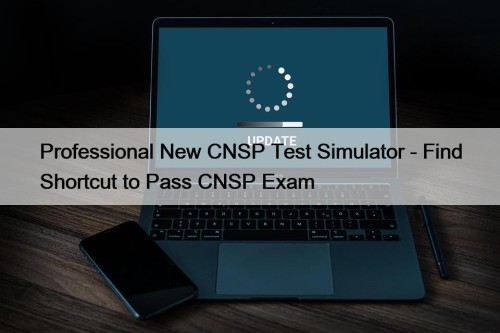Most Popular
 APMG-International AgilePM-Practitioner Test Questions Pdf - AgilePM-Practitioner Reliable Test Materials
APMG-International AgilePM-Practitioner Test Questions Pdf - AgilePM-Practitioner Reliable Test Materials
2025 Latest Prep4King AgilePM-Practitioner PDF Dumps and AgilePM-Practitioner Exam Engine ...
 Professional New CNSP Test Simulator - Find Shortcut to Pass CNSP Exam
Professional New CNSP Test Simulator - Find Shortcut to Pass CNSP Exam
In today's competitive technology sector, the The SecOps Group CNSP ...
 2025 CAS-004–100% Free Valid Mock Exam | Reliable Visual CAS-004 Cert Exam
2025 CAS-004–100% Free Valid Mock Exam | Reliable Visual CAS-004 Cert Exam
Free4Dump CompTIA CAS-004 practice test software is the answer if ...



Professional New CNSP Test Simulator - Find Shortcut to Pass CNSP Exam

In today's competitive technology sector, the The SecOps Group CNSP certification is a vital credential. Many applicants, however, struggle to obtain up-to-date and genuine The SecOps Group CNSP exam questions in order to successfully prepare for the exam. If you find yourself in this circumstance, don't worry since PassLeader has you covered with their real The SecOps Group CNSP Exam Questions. Let's look at the characteristics of these Certified Network Security Practitioner test Questions and how they can help you pass the The SecOps Group CNSP certification exam on the first try.
The simulation of the actual The SecOps Group CNSP test helps you feel the real CNSP exam scenario, so you don't face anxiety while giving the final examination. You can even access your last test results, which help to realize your mistakes and try to avoid them while taking the The SecOps Group CNSP Certification test.
The SecOps Group CNSP Certification Exam, CNSP Valid Braindumps Questions
In today's technological world, more and more students are taking the Certified Network Security Practitioner (CNSP) exam online. While this can be a convenient way to take a Certified Network Security Practitioner (CNSP) exam dumps, it can also be stressful. Luckily, PassLeader's best The SecOps Group CNSP exam questions can help you prepare for your The SecOps Group CNSP Certification Exam and reduce your stress. If you are preparing for the Certified Network Security Practitioner (CNSP) exam dumps our CNSP Questions help you to get high scores in your Certified Network Security Practitioner (CNSP) exam.
The SecOps Group CNSP Exam Syllabus Topics:
| Topic | Details |
|---|---|
| Topic 1 |
|
| Topic 2 |
|
| Topic 3 |
|
| Topic 4 |
|
| Topic 5 |
|
| Topic 6 |
|
| Topic 7 |
|
| Topic 8 |
|
| Topic 9 |
|
| Topic 10 |
|
| Topic 11 |
|
| Topic 12 |
|
| Topic 13 |
|
| Topic 14 |
|
| Topic 15 |
|
The SecOps Group Certified Network Security Practitioner Sample Questions (Q61-Q66):
NEW QUESTION # 61
Which of the following protocols is not vulnerable to address spoofing attacks if implemented correctly?
- A. ARP
- B. UDP
- C. TCP
- D. IP
Answer: C
Explanation:
Address spoofing fakes a source address (e.g., IP, MAC) to impersonate or amplify attacks. Analyzing protocol resilience:
C . TCP (Transmission Control Protocol):
Mechanism: Three-way handshake (SYN, SYN-ACK, ACK) verifies both endpoints.
Client SYN (Seq=X), Server SYN-ACK (Seq=Y, Ack=X+1), Client ACK (Ack=Y+1).
Spoofing Resistance: Spoofer must predict the server's sequence number (randomized in modern stacks) and receive SYN-ACK, impractical without session hijacking or MITM.
Correct Implementation: RFC 793-compliant, with anti-spoofing (e.g., Linux tcp_syncookies).
A . UDP:
Connectionless (RFC 768), no handshake. Spoofed packets (e.g., source IP 1.2.3.4) are accepted if port is open, enabling reflection attacks (e.g., DNS amplification).
B . ARP (Address Resolution Protocol):
No authentication (RFC 826). Spoofed ARP replies (e.g., fake MAC for gateway IP) poison caches, enabling MITM (e.g., arpspoof).
D . IP:
No inherent validation at Layer 3 (RFC 791). Spoofed source IPs pass unless filtered (e.g., ingress filtering, RFC 2827).
Security Implications: TCP's handshake makes spoofing harder, though not impossible (e.g., blind spoofing with sequence prediction, mitigated since BSD 4.4). CNSP likely contrasts this with UDP/IP's vulnerabilities in DDoS contexts.
Why other options are incorrect:
A, B, D: Lack handshake or authentication, inherently spoofable.
Real-World Context: TCP spoofing was viable pre-1990s (e.g., Mitnick attack); modern randomization thwarts it.
NEW QUESTION # 62
Which of the following commands will work on a Microsoft operating system to add a new domain admin user?
- A. net group "Administrator" John /add
- B. net user John "Domain Admins" /add /domain
- C. net user John /add /domain /admin
- D. net group "Domain Admins" John /add /domain
Answer: D
Explanation:
Adding a user to a domain group like "Domain Admins" requires the correct command and scope (domain vs. local).
Why A is correct: net group "Domain Admins" John /add /domain adds user John to the domain-level "Domain Admins" group, per CNSP's domain privilege management.
Why other options are incorrect:
B: net user creates users, not group memberships; syntax is wrong.
C: /admin is invalid; correct group specification is missing.
D: Targets local "Administrator" group, not domain "Domain Admins".
NEW QUESTION # 63
If you find the 111/TCP port open on a Unix system, what is the next logical step to take?
- A. Telnet to the port to look for a banner.
- B. Run "rpcinfo -p <hostname>" to enumerate the RPC services.
- C. None of the above.
- D. Telnet to the port, send "GET / HTTP/1.0" and gather information from the response.
Answer: B
Explanation:
Port 111/TCP is the default port for the RPC (Remote Procedure Call) portmapper service on Unix systems, which registers and manages RPC services.
Why A is correct: Running rpcinfo -p <hostname> queries the portmapper to list all registered RPC services, their programs, versions, and associated ports. This is a logical next step during a security audit or penetration test to identify potential vulnerabilities (e.g., NFS or NIS services). CNSP recommends this command for RPC enumeration.
Why other options are incorrect:
B . Telnet to the port to look for a banner: Telnet might connect, but RPC services don't typically provide a human-readable banner, making this less effective than rpcinfo.
C . Telnet to the port, send "GET / HTTP/1.0" and gather information from the response: Port 111 is not an HTTP service, so an HTTP request is irrelevant and will likely fail.
D . None of the above: Incorrect, as A is a valid and recommended step.
NEW QUESTION # 64
On a Microsoft Windows Operating System, what does the following command do?
net localgroup administrators
- A. List domain admin users for the current domain
- B. Displays the local administrators group on the computer
Answer: B
Explanation:
The net command in Windows is a legacy tool for managing users, groups, and network resources. The subcommand net localgroup <groupname> displays information about a specified local group on the machine where it's run. Specifically:
net localgroup administrators lists all members (users and groups) of the local Administrators group on the current computer.
The local Administrators group grants elevated privileges (e.g., installing software, modifying system files) on that machine only, not domain-wide.
Output Example:
Alias name administrators
Comment Administrators have complete and unrestricted access to the computer Members
------------------------------------------------------------------------------- Administrator Domain Admins The command completed successfully.
Technical Details:
Local groups are stored in the Security Accounts Manager (SAM) database (e.g., C:WindowsSystem32configSAM).
This differs from domain groups (e.g., Domain Admins), managed via Active Directory.
Security Implications: Enumerating local admins is a reconnaissance step in penetration testing (e.g., to escalate privileges). CNSP likely covers this command for auditing and securing Windows systems.
Why other options are incorrect:
A . List domain admin users for the current domain: This requires net group "Domain Admins" /domain, which queries the domain controller, not the local SAM. net localgroup is strictly local.
Real-World Context: Attackers use this command post-compromise (e.g., via PsExec) to identify privilege escalation targets.
NEW QUESTION # 65
WannaCry, an attack, spread throughout the world in May 2017 using machines running on outdated Microsoft operating systems. What is WannaCry?
- A. Malware
- B. Ransomware
Answer: B
Explanation:
WannaCry is a ransomware attack that erupted in May 2017, infecting over 200,000 systems across 150 countries. It exploited the EternalBlue vulnerability (MS17-010) in Microsoft Windows SMBv1, targeting unpatched systems (e.g., Windows XP, Server 2003). Developed by the NSA and leaked by the Shadow Brokers, EternalBlue allowed remote code execution.
Ransomware Mechanics:
Encryption: WannaCry used RSA-2048 and AES-128 to encrypt files, appending extensions like .wcry.
Ransom Demand: Displayed a message demanding $300-$600 in Bitcoin, leveraging a hardcoded wallet.
Worm Propagation: Self-replicated via SMB, scanning internal and external networks, unlike typical ransomware requiring user interaction (e.g., phishing).
Malware Context: While WannaCry is malware (malicious software), "ransomware" is the precise subcategory, distinguishing it from viruses, trojans, or spyware. Malware is a broad term encompassing any harmful code; ransomware specifically encrypts data for extortion. CNSP likely classifies WannaCry as ransomware to focus on its payload and mitigation (e.g., patching, backups).
Why other options are incorrect:
B . Malware: Correct but overly generic. WannaCry's defining trait is ransomware behavior, not just maliciousness. Specificity matters in security taxonomy for threat response (e.g., NIST IR 8019).
Real-World Context: WannaCry crippled NHS hospitals, highlighting patch management's criticality. A kill switch (a domain sinkhole) halted it, but variants persist.
NEW QUESTION # 66
......
The The SecOps Group braindumps torrents available at PassLeader are the most recent ones and cover the difficulty of CNSP test questions. Get your required exam dumps instantly in order to pass CNSP actual test in your first attempt. Don't waste your time in doubts and fear; Our CNSP Practice Exams are absolutely trustworthy and more than enough to obtain a brilliant result in real exam.
CNSP Certification Exam: https://www.passleader.top/The-SecOps-Group/CNSP-exam-braindumps.html
- CNSP Dump File 💡 Braindumps CNSP Torrent 📧 Pass CNSP Guide 📉 Open ⇛ www.testkingpdf.com ⇚ enter ⏩ CNSP ⏪ and obtain a free download 🟠CNSP Real Exams
- Pass Guaranteed Quiz 2025 The SecOps Group CNSP: Pass-Sure New Certified Network Security Practitioner Test Simulator 👵 Go to website ( www.pdfvce.com ) open and search for ☀ CNSP ️☀️ to download for free 🍌CNSP Certification Test Questions
- Reliable CNSP Dumps Ppt 🐺 CNSP Dumps Free Download 🦙 CNSP Dump File 💻 Download ➠ CNSP 🠰 for free by simply entering ➡ www.real4dumps.com ️⬅️ website 🏥CNSP Popular Exams
- Quiz Perfect The SecOps Group - CNSP - New Certified Network Security Practitioner Test Simulator 😸 Simply search for ▷ CNSP ◁ for free download on ➤ www.pdfvce.com ⮘ 🍚CNSP Best Study Material
- CNSP Valid Exam Forum 😯 Brain CNSP Exam 🤳 CNSP Best Study Material 👍 Go to website “ www.testsdumps.com ” open and search for ☀ CNSP ️☀️ to download for free 📄CNSP Valid Exam Forum
- Quiz Perfect The SecOps Group - CNSP - New Certified Network Security Practitioner Test Simulator 🍿 Search for ⇛ CNSP ⇚ on ➠ www.pdfvce.com 🠰 immediately to obtain a free download 🛐CNSP Dump File
- 100% Pass-Rate New CNSP Test Simulator Offer You The Best Certification Exam | Certified Network Security Practitioner ⏪ Download ⏩ CNSP ⏪ for free by simply entering ⇛ www.real4dumps.com ⇚ website 🦠CNSP Reliable Exam Review
- Top New CNSP Test Simulator | Reliable CNSP Certification Exam: Certified Network Security Practitioner 🗽 Copy URL { www.pdfvce.com } open and search for ⏩ CNSP ⏪ to download for free 📯CNSP Exam Sample Online
- Pass CNSP Guide 🔎 CNSP Real Exams ↙ CNSP Dumps Free Download 🏡 Download ▛ CNSP ▟ for free by simply entering [ www.exam4pdf.com ] website 🧾CNSP Dump File
- Top New CNSP Test Simulator | Reliable CNSP Certification Exam: Certified Network Security Practitioner 🛸 Open website ⮆ www.pdfvce.com ⮄ and search for [ CNSP ] for free download 🐴CNSP Exam Sample Online
- CNSP Valid Exam Forum 🌀 CNSP Dumps Download 🦖 CNSP Real Exams 🗯 Go to website 【 www.vceengine.com 】 open and search for ▶ CNSP ◀ to download for free 👵CNSP Reliable Exam Review
- CNSP Exam Questions
- neilgre795.blogcudinti.com tc.chonghua.net.cn skhealer.com e-learning.gastroinnovation.eu lms.susantexperts.com learn-step.com indianinstituteofcybersecurity.com elearn.hicaps.com.ph leowals129.blogpayz.com temp9.henrypress.net
Tags: New CNSP Test Simulator, CNSP Certification Exam, CNSP Valid Braindumps Questions, Reliable CNSP Test Vce, CNSP Exam Objectives Pdf